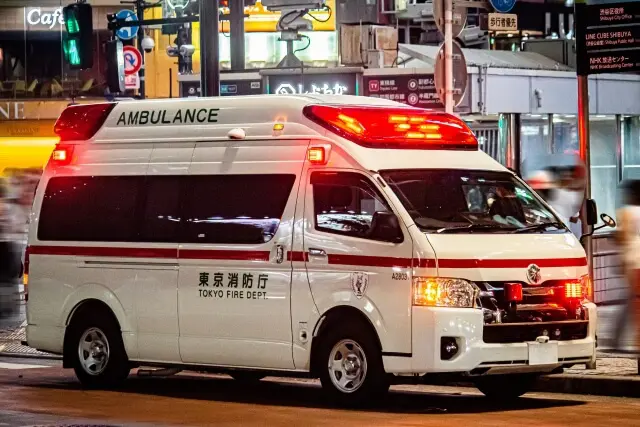Summary of this Article
When labor pains or water breaking occurs, it is important to respond calmly. This article introduces common issues and infections during pregnancy, along with information on how to transfer to a medical facility when labor or water breaking occurs. It also provides emergency response measures.
- Common Issues During Pregnancy
- Infections to Be Cautious About During Pregnancy
- Means of Transportation During Labor Pains and Water Breaking
- Means of Transportation to Avoid During Labor Pains and Water Breaking
- Cases When Pregnant Women Should Call an Ambulance
- Cases with severe pain or heavy bleeding where movement is impossible
- Cases with severe headaches where movement is impossible
- Cases where the baby is visible, and immediate delivery seems likely
- If in doubt, call your regular doctor or emergency consultation hotline
- If a chromosomal abnormality is discovered during pregnancy, consider Hiro Clinic’s NIPT (Non-Invasive Prenatal Testing)
- Frequently Asked Questions
During pregnancy, various anxieties are inevitable until the moment of childbirth. Throughout pregnancy, there is a possibility of encountering various infections and issues. Moreover, if labor pains or water breaking occurs, it is crucial to remain calm and handle the situation without panicking.
This article introduces common issues and infections that may arise during pregnancy. It also provides information on means of transportation to medical facilities when labor pains or water breaking occurs, as well as emergency response measures. To be able to handle the situation calmly when it comes time for childbirth, it’s important to understand in advance the means of transportation and emergency responses. Let’s deepen our understanding of these aspects beforehand.
Common Issues That Can Occur During Pregnancy
There is a possibility of various issues occurring during pregnancy, and even slight discomfort or symptoms can sometimes lead to significant concerns. Here, we will introduce common problems that are prone to occur during the early, mid, and late stages of pregnancy.
Early Pregnancy (Up to 13 weeks 6 days)
Common troubles during early pregnancy include morning sickness, nausea, genital bleeding, and abdominal pain. Symptoms like loss of appetite, nausea, stomach discomfort, stomachache, and vomiting are generally common. However, if worsened, there is a risk of developing hyperemesis gravidarum, characterized by vomiting with the presence of stomach acid or blood, headaches, dizziness, mild consciousness impairment, and liver function disorders.
While mild bleeding and abdominal pain are typical in early pregnancy, if the bleeding is as much as a menstrual period or if abdominal pain progressively worsens, it’s advisable to consult your regular doctor promptly.
Mid-Pregnancy (14 weeks 0 days to 27 weeks 6 days)
Concerns during mid-pregnancy include threatened premature birth and threatened miscarriage. If you experience bleeding, lower abdominal pain, periodic or sustained lower abdominal tension even with rest, a feeling of water breaking, or a decrease in fetal movement, there may be a risk of threatened premature birth.
Additionally, if there is bleeding, brownish discharge, lower abdominal pain, or lower abdominal tension, there is a risk of threatened miscarriage. If you notice these symptoms and feel anxious, seek medical advice promptly from your regular doctor.
Late Pregnancy (28 weeks~)
Swelling and varicose veins are common during late pregnancy. If you experience swelling in the legs or face upon waking up, and your weight increases by more than 500g per week, there may be a tendency for pregnancy-related edema. If you notice sinking when pressing your shin or forehead with your finger, tightness of rings, or swelling of the eyelids, avoid prolonged sitting or walking.
Moreover, swelling in the veins of the lower limbs or genital area may indicate varicose veins. As this can lead to difficulty walking due to pain, if you are still working, consider consulting your workplace to reduce working hours or tasks that exert significant strain on your body.
Infections to Be Cautious About During Pregnancy
During pregnancy, the immune system tends to weaken, making individuals more susceptible to infections caused by bacteria and viruses. When pregnant women contract infections, there is a rare possibility of it affecting the unborn baby. Here are three infections to be cautious about during pregnancy.
Rubella
Rubella is a viral rash illness characterized by symptoms such as fever, rash, and swollen lymph nodes. If a pregnant woman becomes infected with the rubella virus before around 20 weeks of pregnancy, there is a potential risk of the baby developing congenital rubella syndrome. The severity and types of symptoms vary depending on the timing of the infection during pregnancy. It is crucial for women to acquire the necessary immunity for infection prevention before pregnancy.
Toxoplasmosis
Toxoplasmosis is an infectious disease caused by a parasitic protozoan called Toxoplasma. The symptoms vary widely depending on the timing of infection and the condition of the infected individual. Congenital toxoplasmosis, which occurs due to infection during pregnancy, can lead to stillbirth or miscarriage and may cause severe symptoms in the baby after birth, such as mental retardation, visual impairment, and cerebral palsy.
Cytomegalovirus Infection
Cytomegalovirus (CMV) infection is a condition that occurs through primary infection, reinfection, or reactivation. If a pregnant woman becomes infected, there is a possibility of transmission to the baby through the placenta, leading to potential development issues. The symptoms can range from asymptomatic to severe, and it is said that primary infection during pregnancy is more likely to be severe. Specific symptoms include low birth weight, jaundice, petechiae, abnormal liver function, decreased platelets, and hearing loss.
Means of Transportation During Labor Pains and Water Breaking
Here are recommendations for how to reach the hospital when labor pains or water breaking occurs unexpectedly. To avoid panic and the use of unsafe methods to reach the hospital, it’s essential to decide on transportation in advance.
Ask family to provide a car
If you own a car, have a family member drive you to the hospital. Having a family member as the driver allows the pregnant woman to feel secure and the family to monitor her condition, ensuring a safe journey to the hospital. Since labor pains can occur suddenly, it’s advisable to prepare in advance so that a family member can quickly transport you to the hospital when the due date is approaching. Additionally, consider multiple routes to the hospital, as the route may be congested on the day of delivery.
Utilize labor pain taxis
If family members are unavailable due to work when labor pains occur, consider using labor pain taxis. Labor pain taxis are a service where information about the pregnant woman is registered in advance, allowing for immediate transportation to the hospital when labor begins. Instead of calling a labor pain taxi immediately when labor starts, contact the regular doctor first and then arrange for a labor pain taxi.

Is it Better Not to Call an Ambulance?
In general, the onset of labor does not necessarily mean an immediate need for an ambulance. Therefore, for a routine childbirth, it is recommended to seek transportation from family members or use a labor pain taxi instead of calling an ambulance. Ambulances are reserved for high-priority emergencies. If you find yourself alone when experiencing labor pains and feel anxious, rather than calling an ambulance, it is advisable to first remain calm and consult with your regular doctor for guidance.
Means of Transportation to Avoid During Labor Pains and Water Breaking
When experiencing labor pains or water breaking and heading to the hospital, it’s crucial to be aware of transportation methods that should be avoided for a safe arrival. While calling an ambulance may not be necessary for regular labor, it’s important to have a plan in place to handle any issues that may arise during transportation.
Use of Public Transportation
Avoid traveling to the hospital using public transportation such as trains or buses. There is a possibility of feeling unwell or experiencing bleeding during the journey, and public transportation may not provide immediate assistance in case of sudden changes in health.
Walking to the Hospital
Minimize walking to the hospital, even if the contractions are mild. There is a potential risk of water breaking or the pain intensifying, making it difficult to move. While the intervals between contractions may not immediately shorten, unexpected changes in health can still occur. Prioritize the safety of both the mother and the baby and refrain from walking to the hospital.
Driving Yourself
It’s advisable to avoid driving yourself to the hospital when experiencing labor pains or water breaking. Even if the pain is mild, driving on your own may lead to worsening health during the journey. There is a possibility of sudden, severe pain making movement difficult. If your health deteriorates while driving, you may become unable to continue driving, posing the risk of an accident. Even with mild symptoms, consider asking a family member for a ride or using a labor pain taxi.
Cases Where Pregnant Women Should Call an Ambulance
In general, it is not necessary to call an ambulance unless it is an emergency, but it is important to rely on an ambulance in cases of sudden and significant changes in health, especially for pregnant women heading to the hospital. Here, we will introduce situations in which it is advisable for a pregnant woman to call an ambulance when heading to the hospital.
It is crucial to be aware of scenarios where calling an ambulance in advance is recommended to avoid panic in the event of sudden labor pains, rupture of membranes (water breaking), or other health changes associated with pregnancy.
Cases where calling an ambulance is advisable during pregnancy
If you are experiencing intense pain to the extent that you cannot move or if there is heavy bleeding, it is advisable to use an ambulance. There is a possibility that you may not be able to assess the situation on your own in the event of a medical emergency. If your family is present, communicate the situation to them and have them call your regular doctor. Seeking guidance from the doctor and handling the situation calmly is crucial.
Cases with Immobilizing Headaches
During the later stages of pregnancy, the risk of pregnancy-induced hypertension increases. Pregnant women are more susceptible to high blood pressure, and if there is an abnormal and sudden onset of severe headaches, it may indicate a rapid increase in blood pressure. In such cases, both the pregnant woman and the baby may be at risk. Therefore, if you experience intense headaches, arranging for an ambulance is recommended.
Cases where the Baby is Imminent and About to be Born
If labor contractions or water breaking occurs, and the baby’s head is already visible, indicating an imminent birth, it is advisable to call an ambulance. If contractions are intense and close together, family members can support by arranging for an ambulance. In situations where an immediate judgment is challenging, contacting the regular doctor first is also a viable option. Explaining the situation and seeking advice on whether an ambulance is needed is advisable.
If in Doubt, Call Your Regular Doctor or Emergency Consultation Line
In cases where it is uncertain whether to call an ambulance, contacting your regular doctor, emergency consultation line, or the designated medical facility on duty is recommended. For first-time pregnancies, it may be challenging to determine if labor pains or water breaking are typical. Contacting medical professionals allows for immediate consultation, especially during nighttime occurrences.
Moreover, in addition to your regular doctor, contacting an emergency consultation line provides access to experienced medical advisors, doctors, and nurses who are available 24/7. Given the anxiety that can accompany the onset of labor pains or water breaking, seeking advice promptly from experts can help ease concerns.
To ensure a safe childbirth, if in doubt, promptly contact your regular doctor, emergency consultation line, or the designated medical facility on duty.
If Discovering Chromosomal Abnormalities During Pregnancy, Consider Hiro Clinic’s NIPT (Non-Invasive Prenatal Testing)
For those experiencing their first childbirth, anxiety is a natural part of the process. To handle sudden occurrences such as labor pains or water breaking calmly, it is essential to pre-determine the transportation method to the hospital. Additionally, it is crucial to be aware of cases where calling an ambulance is advisable. When labor begins, emotions can overwhelm, potentially hindering sound judgment. Seeking advice from your regular doctor or an emergency consultation line is essential for a safe journey to the hospital.
Moreover, during pregnancy, various health issues can arise. It is important to be cautious of infections, as they can impact both the mother and the baby. Hiro Clinic offers Non-Invasive Prenatal Testing (NIPT) as part of its services. If you wish to confirm chromosomal abnormalities in your baby during pregnancy, consider utilizing this option. Being aware of potential troubles before childbirth allows for better preparation and peace of mind.
【References】
Q&A
-
QShould I undergo NIPT (Non-Invasive Prenatal Testing)?Understanding the possibility of chromosomal abnormalities allows for advance mental preparation and planning. However, for some individuals, there is also the potential for test results to induce anxiety. Therefore, it is recommended to discuss the testing with family members before undergoing it.
-
QWhen will the test results be notified?We typically deliver the results within 8 days from the blood sample collection.
Article Editorial Supervisor

岡 博史先生
【役職】
【資格】
【略歴】
【所属】
【SNS】
 中文
中文












